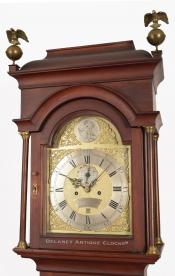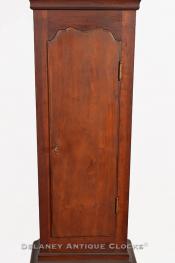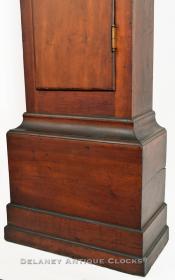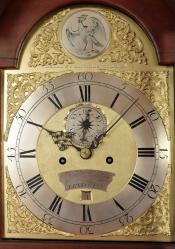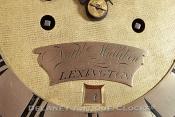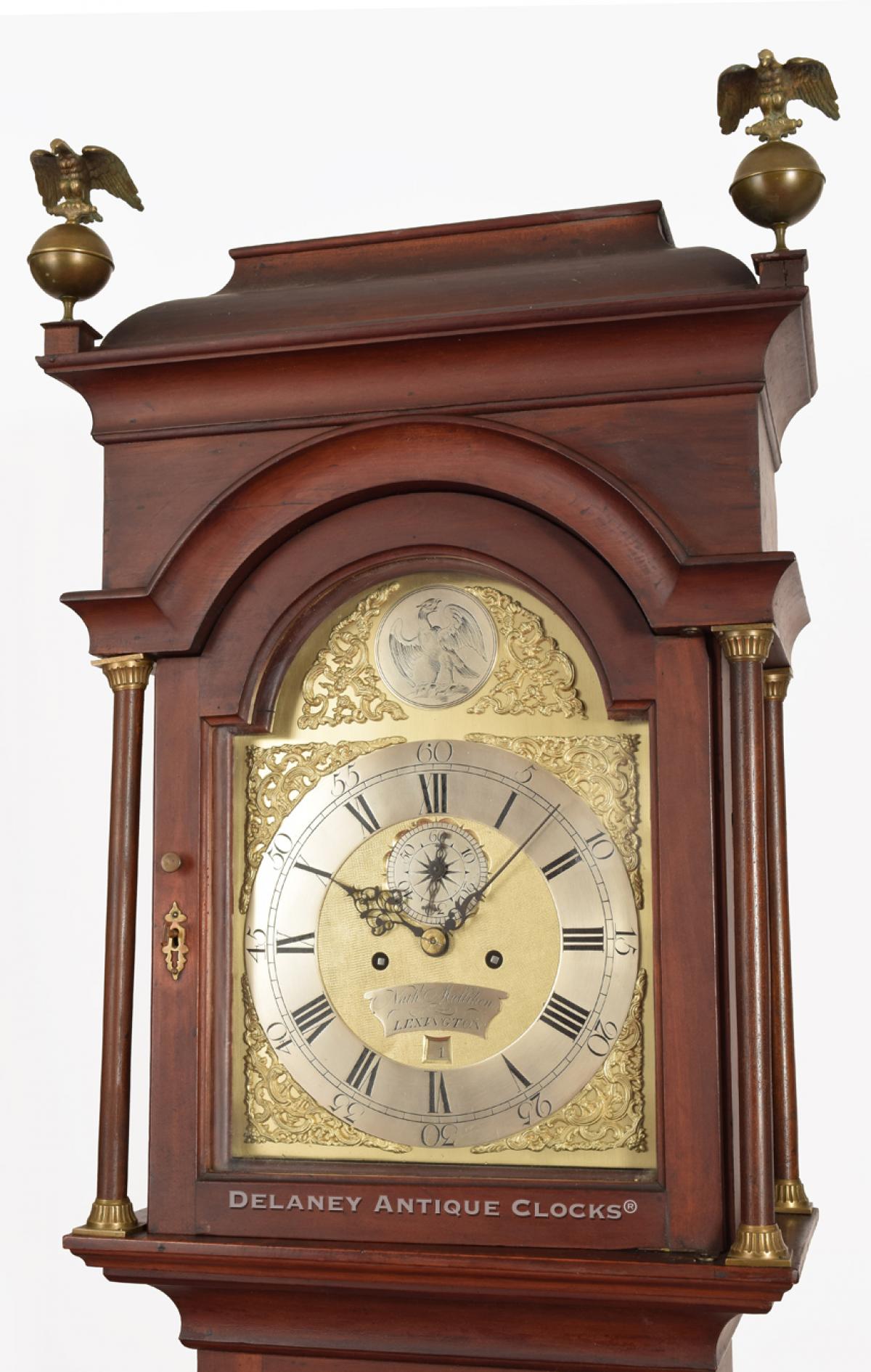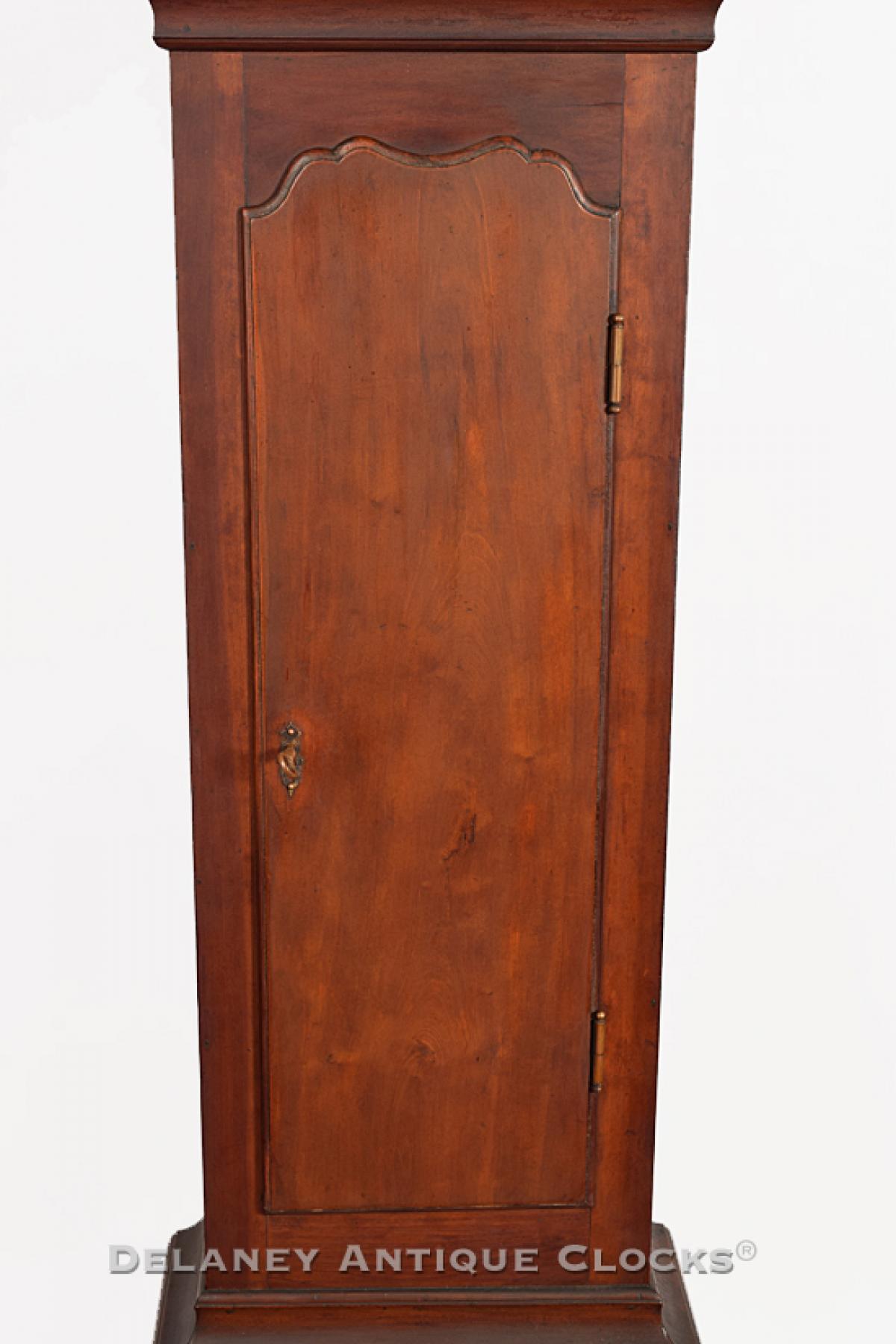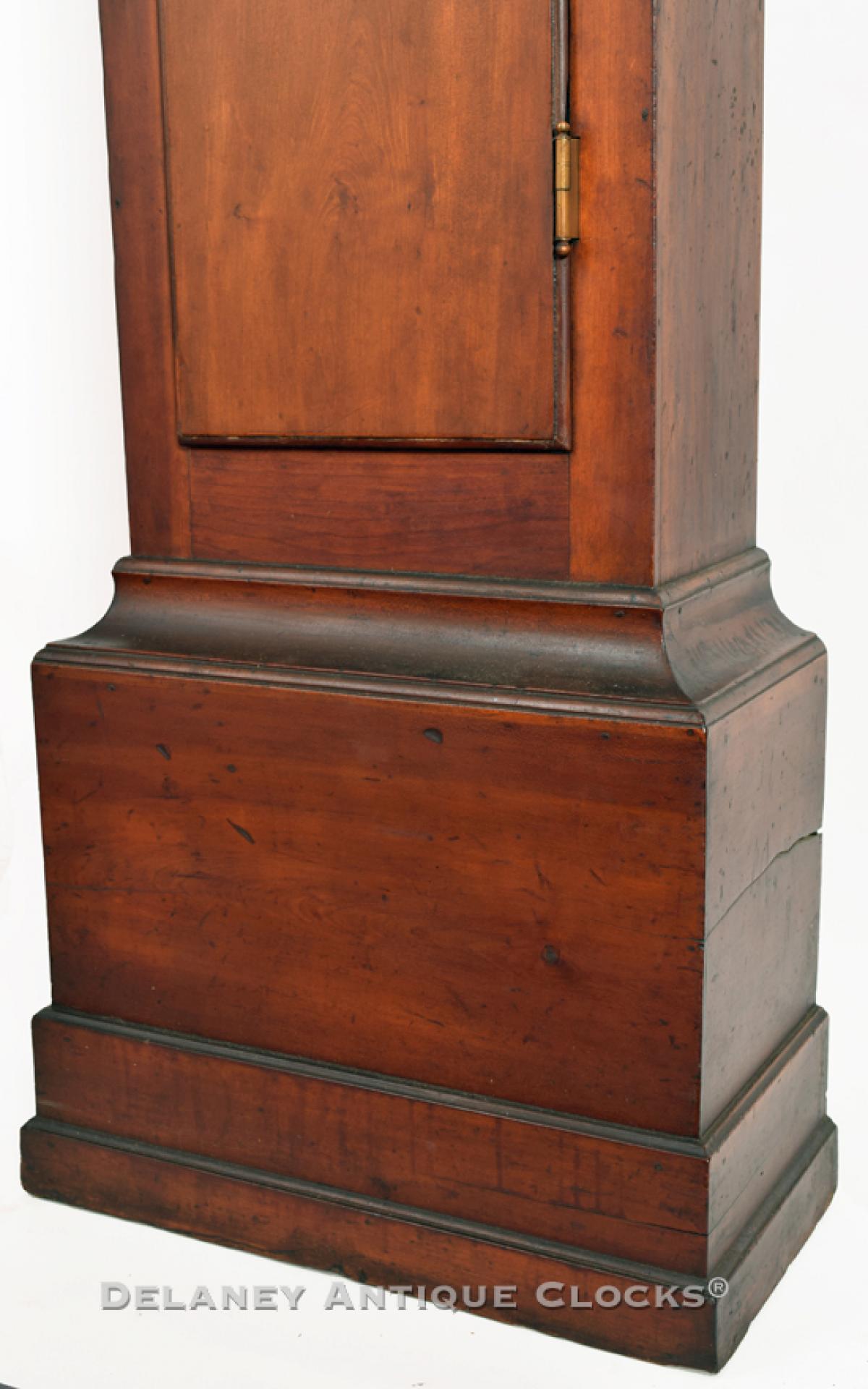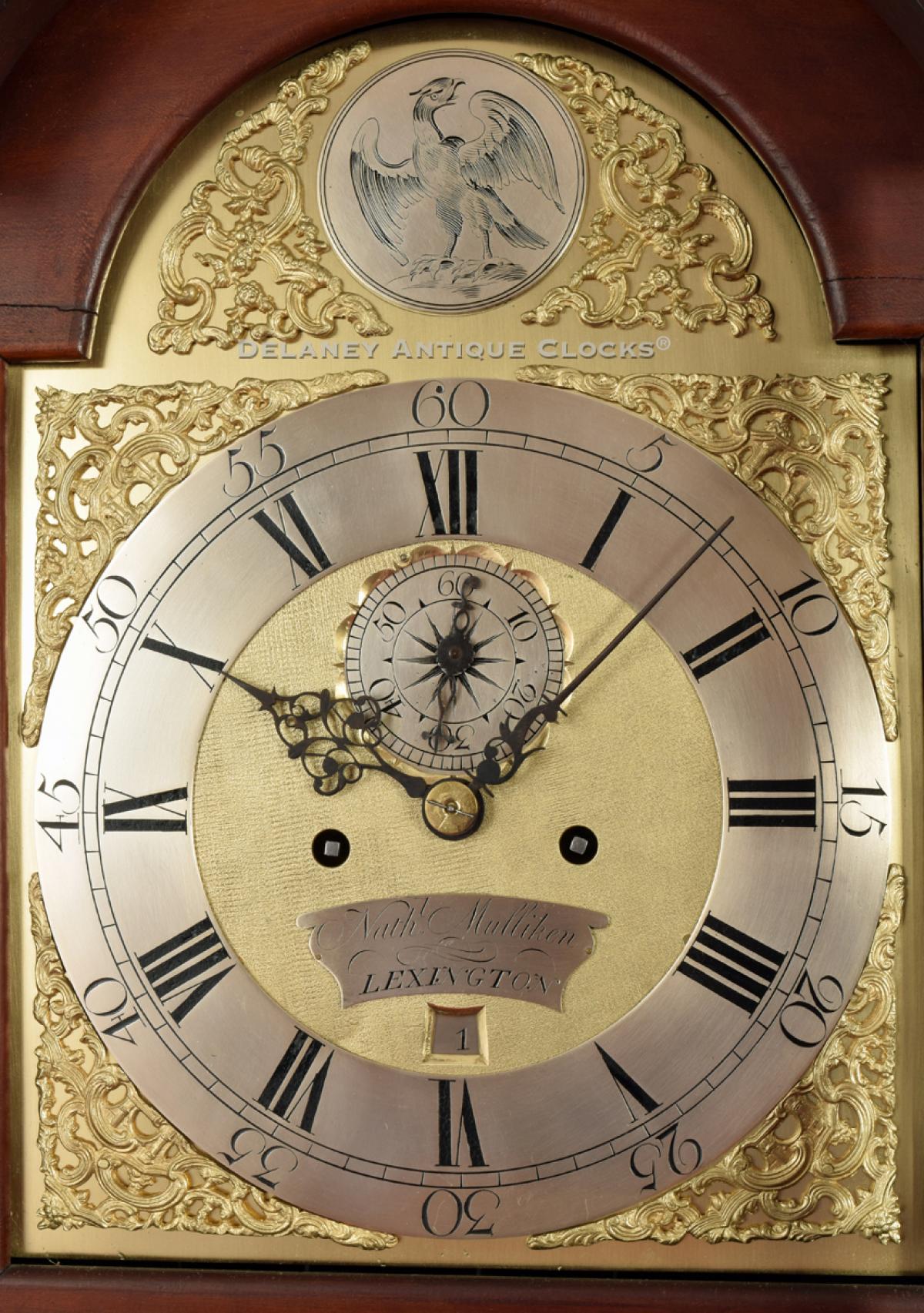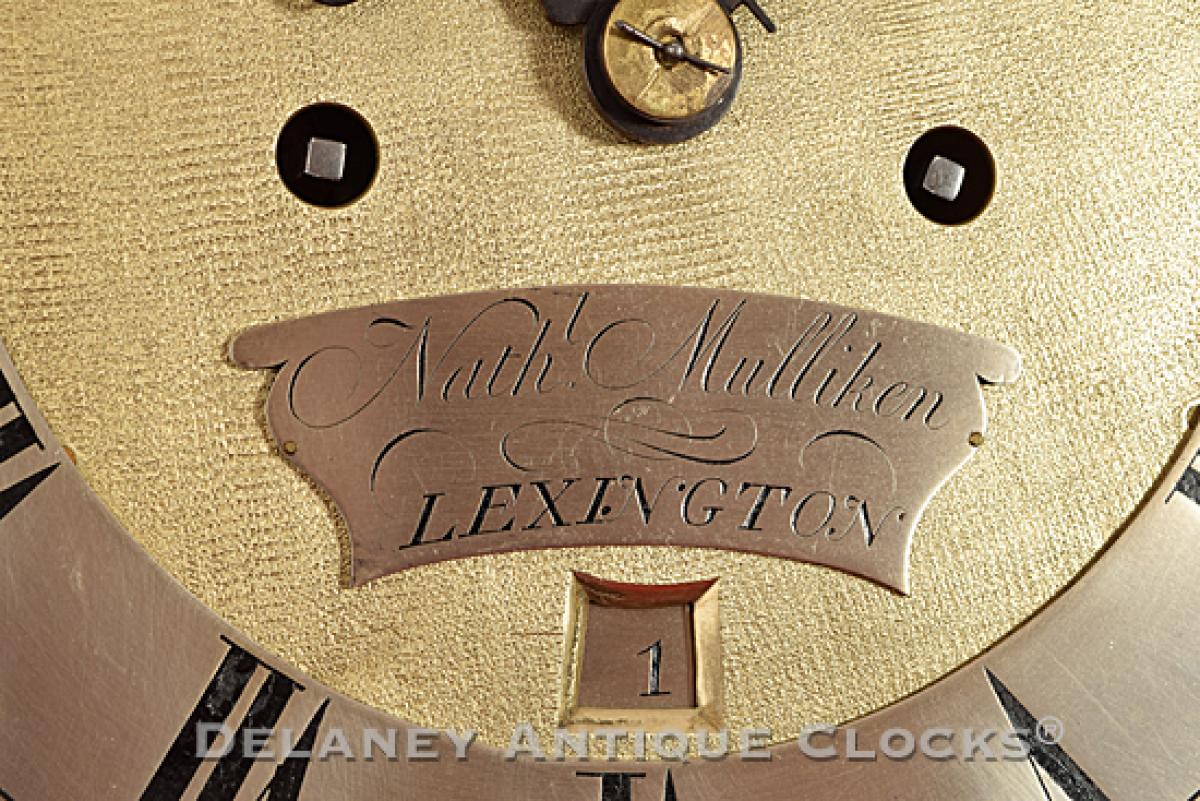Nathaniel Mulliken (1722-1777) of Lexington, Massachusetts. A maple cased pre-revolutionary tall clock. YY7.
An important maple cased tall clock made by Nathaniel Mulliken in Lexington, Massachusetts. He was a member of a very important family of American clock makers. Very few American Pre-Revolutionary clocks were made in this country and fewer survive. This is a very fine example in wonderful condition and retains an older first period finish. The color is excellent.
This case is supported on a double stepped bracket base. The design rest flat to the floor and is applied to the base section. The base is somewhat compressed. This is a common design detail for clock cases manufactured in the Colonies during this early period. The waist section is long and centers a large waist door that is wonderfully shaped at the top. This door is trimmed along its perimeter with a molded edge. It is hinged and opens to allow one access to the interior of the case. This is where one will find the two drive weights and the brass faced pendulum bob. The bonnet features a caddy or sarcophagus top. This style of bonnet is also an early form. The sarcophagus is original to this clock and has not been modified. This design feature is positioned above a molded arch that conforms to the shape of the dial door and the dial. Two brass finials are mounted out on the corners of the hood. These are positioned on plinths. The molded arch is visually supported by two free standing colonettes. These are smoothly turned and mounted in brass capitals. The bonnet door is arched in form and opens to access the composite brass dial.
This style of dial predates the painted dial form. It is composed of a brass sheet and is decorated with a number of decorative elements. Four cast corner spandrels frame the applied time ring. There are two additional spandrels in the arch. These center a circular shaped boss that is engraved with a powerful image of an eagle. The silvered time or chapter ring, features Arabic style five minute markers, a closed minute ring and large Roman style hour numerals. Inside this ring the dial surface has been textured. Here one will also find a display for the calendar day and an inset subsidiary seconds dial. This dial is also engraved and the framing has been decorated with a scolloped design. A large plaque is engraved with the Maker's name. This engraved name plate reads. "Nathl. Mulliken \/ LEXINGTON." The hands are wonderfully hand filed. The skill exhibited here is very high.
The two train movement is brass, eight-day duration and of good quality. Four turned brass pillars or posts support the two large brass plates. Hardened steel shafts support the polished steel pinions and brass gearing. The winding drums are grooved. The escapement is designed as a recoil format. The movement is weight driven and designed to run eight days on a full wind. It is a two train or a time and strike design having a rack and snail striking system. As a result, it will strike each hour on the hour. This is done on a cast iron bell which is mounted above the movement.
This clock was made circa 1755 and stands approximately 7 feet 4 inches (88 inches) tall to the top of the finials, 20.25 inches wide and 10.5 inches deep at the cornice molding.
The Mullikens were prominent family of Massachusetts clockmakers extending in two family lines for three generations. The first Mulliken clockmaker Jonathan, was born in about 1701 and Bradford, Massachusetts. It is thought that he was working as early as 1735 and was responsible for training Samuel I born 1720 and Nathaniel I born 1722 as clockmakers. Nathaniel Mulliken (1722-1767) worked in Bradford until 1751 and then moved to Lexington. He worked here until his death in 1767. He was born on August 8, 1722 in Bradford, to John and Mary (Poore) Mulliken. Some scholars speculate that Nathaniel may have trained Daniel Balch, Benjamin Willard and his son Nathaniel Jr. (1752-1776) in the trade. His son Joseph (1765-1802) was also a clockmaker, and his son John (born 1754) was a cabinetmaker who made clock cases. At Nathaniel Sr.'s death, the business in Lexington was continued on by Nathaniel Jr. until the shop and house were burned to the ground on April 17, 1775 by British troops who were retreating back to Boston. A Mulliken movement was reportedly found in the bag of a deceased British soldier lying on the Boston Road.
Several tall-case clocks with movements by Nathaniel Mulliken are known. One eight day example having a dial engraved with an American eagle is illustrated in Lester Dworetsky and Robert Dickstein, Horology Americana, 1972, on page 2. Brooks Palmer also documents in The Book of American Clocks, 1950, p. 246. a Mulliken clock from the collection of J. Cheney Wells with a brass dial and maple case that was exhibited at the Harvard Tercentenary. This clock is now on display at Old Sturbridge Village. Another is illustrated in "Living with Antiques: The Brick House, New Hampshire of Mrs. Thomas C. Dunnington\, The Magazine Antiques (July 1964) page 75. Another example is in the collection of the Concord Antiquarian Society and is illustrated in The Magazine Antiques (December 1974).
"Nathaniel was a member of a very important family of American clockmakers extending in two family lines for three generations. He was born in Bradford, Massachusetts, on August 8, 1722. His parents were John and Mary (Poore) Mulliken of Bradford, Massachusetts. It is thought that he served his clockmaking apprenticeship to his uncle Jonathan Mulliken (b. circa 1701), who was working in Bradford as early as 1735. Nathaniel also worked in Bradford until approximately 1751, when he married Lydia Stone. She was the daughter of Deacon John Stone of Lexington, who lived near the town line of Lincoln. It is said that Nathaniel left a clock with the Deacon "on trial." When he returned for payment, the courtship began with his daughter. Together, Nathaniel and Lydia bought a small house and shop on the main road now called Massachusetts Avenue. It was located on the rise of ground across the street from the lower entrance of the cemetery and just above the Munroe Tavern. Nathaniel was also a blacksmith and was proud of the andirons he made. They had at least seven children. Two of which also made clocks. Nathaniel Jr. was born on March 30, 1752, and Joseph was born on April 9, 1765, in the same town. Nathaniel lived and worked in Lexington until his death in 1767. It is thought that he trained other clockmakers besides his sons, including Benjamin Willard. Willard moved to Lexington to learn how to make brass works clocks. He is also thought to have trained Daniel Balch of Newbury, Massachusetts. Nathaniel's son John (born 1754) was a cabinetmaker and is recorded as making clock cases. Nathaniel Sr died on Monday, December 3, 1767. He fell at the door of his house and expired a few moments later. Nathaniel Jr. and Benjamin Willard continued the business in Lexington. Nathaniel II maintained this business until the shop, and the house were burned to the ground on April 19, 1775, by British troops while returning to Boston from Concord. A signed Mulliken musical movement designed to play lively tunes during the week and a Psalm tune on Sunday was reportedly found in the knapsack of a wounded British soldier lying on the Boston Road in Malden or Medford. Nathaniel Jr. died the next winter at the age of 24.
Several tall-case clocks with movements by Nathaniel Mulliken are known. One eight-day example of having a dial engraved with an American eagle is illustrated in Lester Dworetsky and Robert Dickstein, Horology Americana, 1972, on page 2. Brooks Palmer also documents this in The Book of American Clocks, 1950, p. 246. a Mulliken clock from the collection of J. Cheney Wells with a brass dial and maple case that was exhibited at the Harvard Tercentenary. This clock is now on display at Old Sturbridge Village. Another is illustrated in "Living with Antiques: The Brick House, New Hampshire of Mrs. Thomas C. Dunnington," The Magazine Antiques (July 1964) page 75. Another example is in the collection of the Concord Antiquarian Society, which is illustrated in The Magazine Antiques (December 1974).


